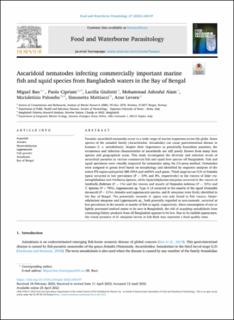| dc.contributor.author | Bao, Miguel | |
| dc.contributor.author | Cipriani, Paolo | |
| dc.contributor.author | Giulietti, Lucilla | |
| dc.contributor.author | Alam, Mohammad Ashraful | |
| dc.contributor.author | Palomba, Marialetizia | |
| dc.contributor.author | Mattiucci, Simonetta | |
| dc.contributor.author | Levsen, Arne | |
| dc.date.accessioned | 2022-08-12T11:26:07Z | |
| dc.date.available | 2022-08-12T11:26:07Z | |
| dc.date.created | 2022-05-12T14:24:55Z | |
| dc.date.issued | 2022 | |
| dc.identifier.citation | Food and Waterborne Parasitology. 2022, 27 . | en_US |
| dc.identifier.issn | 2405-6766 | |
| dc.identifier.uri | https://hdl.handle.net/11250/3011622 | |
| dc.description.abstract | Parasitic ascaridoid nematodes occur in a wide range of marine organisms across the globe. Some species of the anisakid family (Ascaridoidea: Anisakidae) can cause gastrointestinal disease in humans (i. e. anisakidosis). Despite their importance as potentially hazardous parasites, the occurrence and infection characteristics of ascaridoids are still poorly known from many host species and geographical areas. This study investigated the diversity and infection levels of ascaridoid parasites in various commercial fish and squid host species off Bangladesh. Fish and squid specimens were visually inspected for nematodes using the UV-press method. Nematodes were assigned to genus level based on morphology and identified by sequence analyses of the entire ITS region and partial 28S rDNA and mtDNA cox2 genes. Third-stage larvae (L3) of Anisakis typica occurred at low prevalence (P = 10% and 8%, respectively) in the viscera of Selar crumenophthalmus and Trichiurus lepturus, while Hysterothylacium amoyense occurred in the viscera of Sardinella fimbriata (P = 1%) and the viscera and muscle of Harpadon nehereus (P = 32%) and T. lepturus (P = 76%). Lappetascaris sp. Type A L3 occurred in the mantle of the squid Uroteuthis duvaucelii (P = 11%). Anisakis and Lappetascaris species, and H. amoyense were firstly identified in the Bay of Bengal. The potentially zoonotic A. typica was only found in fish viscera. Hysterothylacium amoyense and Lappetascaris sp., both generally regarded as non-zoonotic, occurred at low prevalence in the muscle or mantle of fish or squid, respectively. Since consumption of raw or lightly processed seafood seems to be rare in Bangladesh, the risk of acquiring anisakidosis from consuming fishery products from off Bangladesh appears to be low. Due to its reddish appearance, the visual presence of H. amoyense larvae in fish flesh may represent a food quality issue. | en_US |
| dc.language.iso | eng | en_US |
| dc.title | Ascaridoid nematodes infecting commercially important marine fish and squid species from Bangladesh waters in the Bay of Bengal | en_US |
| dc.title.alternative | Ascaridoid nematodes infecting commercially important marine fish and squid species from Bangladesh waters in the Bay of Bengal | en_US |
| dc.type | Peer reviewed | en_US |
| dc.type | Journal article | en_US |
| dc.description.version | publishedVersion | en_US |
| dc.source.pagenumber | 13 | en_US |
| dc.source.volume | 27 | en_US |
| dc.source.journal | Food and Waterborne Parasitology | en_US |
| dc.identifier.doi | 10.1016/j.fawpar.2022.e00157 | |
| dc.identifier.cristin | 2023991 | |
| cristin.ispublished | true | |
| cristin.fulltext | original | |
| cristin.qualitycode | 1 | |
